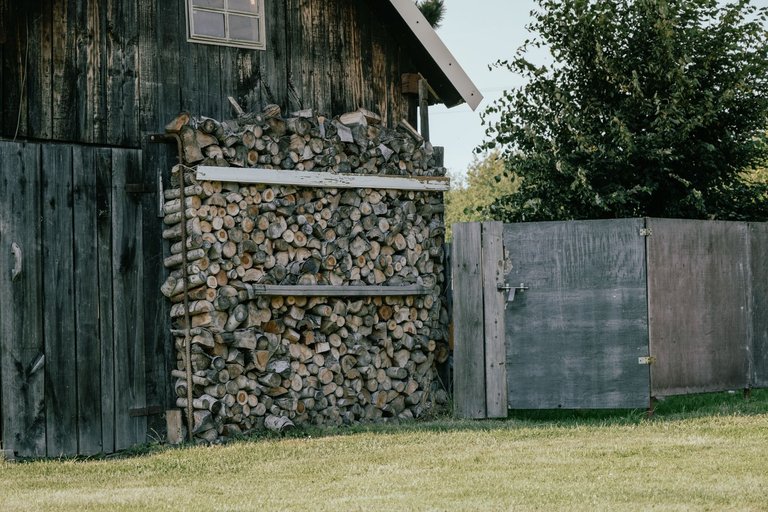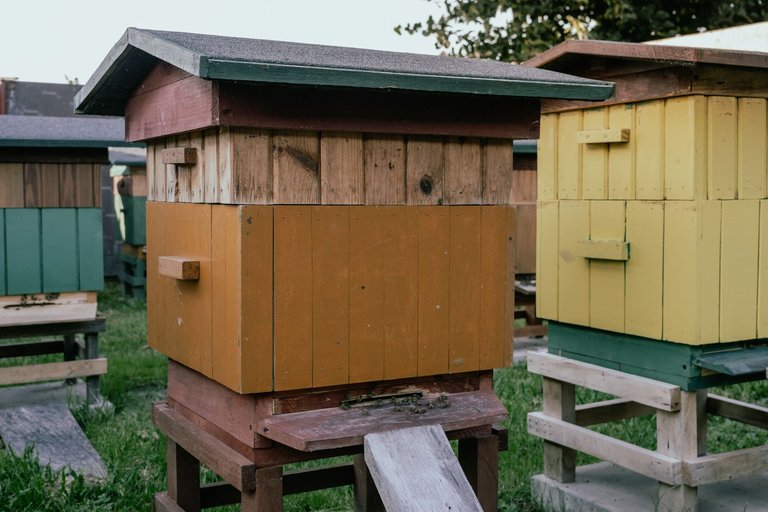Zapraszam na kilka zdjęć z pasieki pszczelej, która kryje się za tą starą drewnianą szopą. Została ogrodzona wysokim płotem, żeby zachęcić pszczoły do wysokiego lotu. Blisko pasieczyska jest dom, właściciel nie chciał, żeby pszczółki nisko latały blisko głowy :)
I invite you to take a look at some photos from the bee apiary, which is hidden behind this old wooden shed. It was fenced with a high fence to encourage bees to fly high. There is a house close to the apiary, the owner didn't want the bees to fly low near his head :)


Chyba wszystkie z tych uli to ule wielkopolskie, aktualnie najczęściej spotykane w Polsce. Prawie każdy z nich został wykonany własnoręcznie przez właściciela. Obok ula ma małą stolarnię z zapleczem technicznym do pszczelarstwa, ale tego niestety nie udało mi się uchwycić na fotografii, może kiedyś pojawi się fotorealacja jak się robi ul :)
Probably all of these hives are Greater Poland hives, currently the most common in Poland. Almost each of them was handmade by the owner. Next to the hive, he has a small carpentry workshop with technical facilities for beekeeping, but unfortunately I wasn't able to capture it in a photo, maybe one day there will be a photorealization of how to make a hive :)





Ule są bardzo podobne do siebie pod względem konstrukcyjnym, ale różnią się kolorami, które ponoć pszczoły dobrze rozróżniają. Podobno pszczoły widzą bardzo dobrze kontrasty kolorów, więc najlepiej ustawiać obok siebie ule różnokolorowe. Często tez pszczelarze robią różne znaki, kółka, krzyżyki, gwiazdki dla lepszego odnalezienia właściwego ula przez pszczoły.
The hives are very similar in terms of design, but they differ in colors, which the bees are said to be able to distinguish well. Apparently bees see color contrasts very well, so it is best to place hives of different colors next to each other. Beekeepers often make various signs, circles, crosses and stars to make it easier for bees to find the right hive.



Zdjęcia zostały zrobione w gorące, wakacyjne dni. Pszczoły lubią mieć optymalną temperaturę. Jeżeli jest za zimno (najczęściej w zimie), to zbijają się w kłąb w ulu, żeby ograniczyć ilość ruchów do wytworzenia ciepła, ekonomiczność się liczy w zimie, żeby zjeść jak naj mniej miodu i żeby rodzina na wiosenny start miała dobry (mocny) rozruch, gdy królowa pszczół zacznie czerwić i pojawią się nowe pszczółki. Na fotografii widać, że dużo pszczół jest na zewnątrz, taki widok można najczęściej spotkać z co najmniej dwóch przypadków, gdy pszczoły się roją (tworzy się nowa rodzina), lub gdy jest im gorąco. W tym przypadku raczej jest im gorąco.
The photos were taken on hot summer days. Bees like to have an optimal temperature. If it is too cold (most often in winter), they huddle in the hive to limit the number of movements needed to generate heat, economy is important in winter, to eat as little honey as possible and for the colony to have a good (strong) start in the spring when the queen bee starts brooding and new bees appear. The photo shows that a lot of bees are outside, this sight can most often be seen due to at least two occasions when the bees are swarming (a new family is being formed) or when they are hot. In this case, they are rather hot.



Pszczoły są fascynujące, kiedyś może postawię sobie kilka uli obok domu, to byłoby ciekawe doświadczenie. Pewnie dzieliłbym się na Hive wieloma fotkami z pszczelich prac. Ale podobno pszczoły najczęściej to na emeryturę się kupuje, więc jeszcze trochę poczekam :D
Bees are fascinating, one day I might build a few hives next to my house, it would be an interesting experience. I would probably share many photos of my bee work on Hive. But apparently bees are most often bought for retirement :D





Others in this series:
Photo by @szejq 📸 | Fuji X + Fujinon XF 16-80mm F4 R OIS WR | Adobe Lightroom